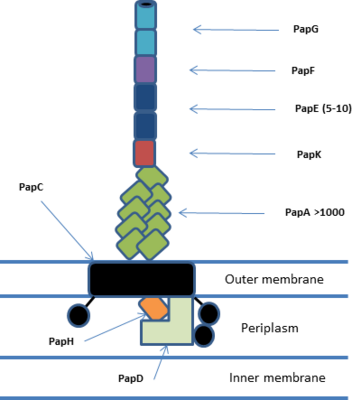Biology:P fimbriae
This article may be too technical for most readers to understand. Please help improve it to make it understandable to non-experts, without removing the technical details. (January 2024) (Learn how and when to remove this template message) |
P fimbriae (also known as pyelonephritis-associated pili, P pili, or Pap) are chaperone-usher type (specifically of the π family)[1] fimbrial appendages found on the surface of many Escherichia coli bacteria.[2] The P fimbriae is considered to be one of the most important virulence factor in uropathogenic E. coli and plays an important role in upper urinary tract infections.[3] P fimbriae mediate adherence to host cells, a key event in the pathogenesis of urinary tract infections.
Structure and expression
P fimbriae are large, linear structures projecting from the surface of the bacterial cell. With lengths of 1-2um, the pili can be larger than the diameter of the bacteria itself.[4] The main body of the fimbriae is composed of approx. 1000 copies of the major fimbrial subunit protein PapA, forming a helical rod.[5] The short fimbrial tip is made of the subunits PapK, PapE, PapF and the tip adhesin PapG, which mediates the binding.
The fimbriae is assembled by a chaperone-usher system, and proteins required for the assembly are expressed by the Pap operon, which is located on pathogenicity islands. The genes of the Pap operon encode five structural proteins (PapA, PapK, PapE, PapF and PapG), four proteins involved in the transport and assembly (PapD, PapH, PapC, PapJ) and two proteins (PapB, PapI) regulating the operon expression.[6][7]
Role during infection
Adherence to host uroepithelial cells is a crucial step during the infection that allows uropathogenic E.coli to colonize the urinary tract and prevents bacterial removal during micturition. The binding of the P fimbriae to epithelial cells is mediated by the tip adhesin PapG. Four different alleles of PapG have been described, which bind to different glycolipid structures on host cells. In humans, especially variant papGII and papGIII have shown to be clinically relevant.
Variant PapGII binds preferentially to globoside (GbO4), found abundantly on human kidney epithelial cells. PapGII triggers a strong inflammatory response which leads to tissue damage.[8] Most E. coli strains causing pyelonephritis, urinary-source bacteremia and urosepsis produce P pili with PapGII.[9] PapGIII binds to the Forssmann antigen (GbO5) as well as isoreceptors present in the urinary tract of humans. E. coli strains carrying the papGIII gene are associated with lower urinary tract infections (cystitis) and asymptomatic bacteriuria. PapGI adhesins bind preferentially to globotriaosylceramide (GbO3), while the isoreceptors of PapGIV are unknown. E. coli carrying genes for PapGI and PapGIV are rarely found in E. coli causing infections in humans.[3][4]
| fecal | asymptomatic bacteriuria | cystitis | pyelonephritis | urosepsis | |
|---|---|---|---|---|---|
| papGII | 15 | 20 | 20 | 60 | 70 |
| papGIII | 10 | 15 | 20 | 20 | 10 |
References
- ↑ "Evolution of the chaperone/usher assembly pathway: fimbrial classification goes Greek". Microbiology and Molecular Biology Reviews 71 (4): 551–575. 2007. doi:10.1128/MMBR.00014-07. PMID 18063717.
- ↑ "Pyelonephritic Escherichia coli expressing P fimbriae decrease immune response of the mouse kidney" (in en-US). Journal of the American Society of Nephrology 16 (12): 3583–91. December 2005. doi:10.1681/ASN.2005030243. PMID 16236807.
- ↑ 3.0 3.1 "Role of P-fimbrial-mediated adherence in pyelonephritis and persistence of uropathogenic Escherichia coli (UPEC) in the mammalian kidney". Kidney International 72 (1): 19–25. July 2007. doi:10.1038/sj.ki.5002230. PMID 17396114.
- ↑ 4.0 4.1 "The role of P fimbriae for Escherichia coli establishment and mucosal inflammation in the human urinary tract". International Journal of Antimicrobial Agents 19 (6): 522–38. June 2002. doi:10.1016/S0924-8579(02)00103-6. PMID 12135844.
- ↑ "Structure of a Chaperone-Usher Pilus Reveals the Molecular Basis of Rod Uncoiling". Cell 164 (1–2): 269–278. January 2016. doi:10.1016/j.cell.2015.11.049. PMID 26724865.
- ↑ "Structural biology of the chaperone-usher pathway of pilus biogenesis". Nature Reviews. Microbiology 7 (11): 765–74. November 2009. doi:10.1038/nrmicro2220. PMID 19820722.
- ↑ "Biogenesis and adhesion of type 1 and P pili". Biochimica et Biophysica Acta (BBA) - General Subjects 1840 (9): 2783–93. September 2014. doi:10.1016/j.bbagen.2014.04.021. PMID 24797039.
- ↑ "Fimbriae reprogram host gene expression - Divergent effects of P and type 1 fimbriae". PLOS Pathogens 15 (6): e1007671. June 2019. doi:10.1371/journal.ppat.1007671. PMID 31181116.
- ↑ 9.0 9.1 "Horizontally acquired papGII-containing pathogenicity islands underlie the emergence of invasive uropathogenic Escherichia coli lineages". Nature Communications 11 (1): 5968. November 2020. doi:10.1038/s41467-020-19714-9. PMID 33235212. Bibcode: 2020NatCo..11.5968B.
- ↑ "papG alleles among Escherichia coli strains causing urosepsis: associations with other bacterial characteristics and host compromise". Infection and Immunity 66 (9): 4568–71. September 1998. doi:10.1128/IAI.66.9.4568-4571.1998. PMID 9712823.
- ↑ "Pap, papG and prsG DNA sequences in Escherichia coli from the fecal flora and the urinary tract". Microbial Pathogenesis 15 (2): 121–9. August 1993. doi:10.1006/mpat.1993.1062. PMID 7902954.
- ↑ "Extended virulence genotypes and phylogenetic background of Escherichia coli isolates from patients with cystitis, pyelonephritis, or prostatitis". The Journal of Infectious Diseases 191 (1): 46–50. January 2005. doi:10.1086/426450. PMID 15593002.
- ↑ "Virulence properties of asymptomatic bacteriuria Escherichia coli". International Journal of Medical Microbiology 299 (1): 53–63. January 2009. doi:10.1016/j.ijmm.2008.06.003. PMID 18706859.
- ↑ "Escherichia coli mediated urinary tract infections: are there distinct uropathogenic E. coli (UPEC) pathotypes?". FEMS Microbiology Letters 252 (2): 183–90. November 2005. doi:10.1016/j.femsle.2005.08.028. PMID 16165319. https://deepblue.lib.umich.edu/bitstream/2027.42/72866/1/j.femsle.2005.08.028.pdf.
 |


